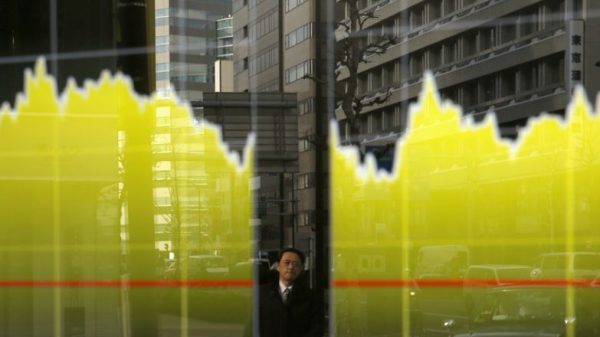Donald Trump has promised Americans that tariffs would make life more affordable and rebuild the US industry.
But the reality Americans are seeing so far is rising prices, squeezed profits, and record sums are flowing into government coffers, paid by the very people tariffs were supposed to protect.
Across every major economic indicator, the numbers are consistent. Import taxes are at their highest levels since the 1930s.
Corporate expenses have surged by more than a trillion dollars. Household budgets are thinner.
And even with tariff revenue at all-time highs, the US economy is now growing more slowly and creating fewer jobs than it would have without them.
The return of record tariffs
The average effective tariff rate in the United States now stands at 18% before substitution and 17% after, according to the latest Budget Lab’s report, the highest since 1934.
That means almost one-fifth of the value of imported goods is being taxed at the border.
Rates that once applied to a few products now cover nearly all major imports, including autos, metals, copper, wood, and furniture.
The scope of the policy is unmatched in modern history.
Since February, tariffs on Chinese goods have climbed to an average of 58%, while imports from Mexico and Canada face rates between 25-35%, depending on exemptions under the USMCA.
Steel and aluminium now face a 50% duty, while new wood tariffs were added in October.
The revenue impact is dramatic. Tariff collections are on pace to reach $111 billion in 2025 and $2.5 trillion over the next decade if the current policy stays in place.
After accounting for slower growth, that figure drops to about $2 trillion, which is still the largest tariff revenue stream in American history.
But who is paying for it? Not China, not Mexico, and not Europe. For now, the data says that nearly all the burden falls on American businesses and consumers.
The trillion-dollar squeeze
A global study by S&P Global Market Intelligence estimates that US companies faced a $1.2 trillion increase in costs this year compared with pre-tariff expectations.
Roughly two-thirds of that expense, which is more than $900 billion, is now being passed to US consumers through higher prices.
The remaining third has been absorbed by firms through thinner profit margins.
This cost shock is showing up across supply chains. In sectors tied to metals, machinery, and retail goods, profit margins have fallen sharply.
Small and mid-size firms, which have less flexibility to shift suppliers, have suffered the deepest hits, with average margin declines of more than 1.6 percentage points this year.
Larger firms, better able to source from tariff-free regions or raise prices, lost about 0.5 percentage points.
Consumers are starting to feel the handover. Prices for imported items and their domestic substitutes have risen in lockstep.
Metals and manufactured goods are up as much as 40% in some categories, while leather and apparel prices have climbed by nearly 30% in the short term.
The cost of a new car has jumped about 9%, adding $4,500 to the sticker price of a typical 2024 model.
Even basic groceries, textiles, and furniture are more expensive.
The effect is clear for millions of households. A Yale Budget Lab estimate suggests tariffs will cost the typical household about $2,400 this year.
The national inflation rate sits near 2.9%, down from pandemic highs, but that headline masks sharp increases in imported consumer goods.
The poorest tenth of households lose 2.7% of disposable income from tariffs, more than three times the loss faced by the top decile.
Even after accounting for income-tax cuts passed earlier this year, most families outside the top 10% are worse off overall.
Slower growth, fewer jobs
Economically, the tariffs function as a supply shock. Costs rise for businesses that depend on imported inputs, leading to slower output and weaker job creation.
According to The Budget Lab, tariffs and foreign retaliation will trim US real GDP growth by about half a percentage point in both 2025 and 2026.
The unemployment rate is projected to rise by 0.3 percentage points by year-end, reaching 0.7 percentage points higher by the end of 2026.
In the long run, the US economy will settle about 0.4% smaller, the equivalent of $125 billion per year in lost output.
Exports are forecast to be 15% lower as trade partners retaliate or shift supply chains elsewhere.
Some sectors see short-term gains. Domestic manufacturing output could rise about 2.5%, with nondurable goods and basic metals showing temporary strength.
But those gains are offset by a contraction in construction, agriculture, and mining.
Manufacturing’s boost does not reflect a broad revival; it’s largely a reallocation of resources within a smaller overall economy.
The fiscal illusion
To supporters, the rising tariff revenue looks like a win. To economists, it’s a fiscal mirage.
A recent analysis by Kimberly Clausing and Maurice Obstfeld describes the 2025 policy shift as “fiscal folly.”
While tariffs might collect around $2 trillion over a decade, the 2025 tax cuts will cost $3.4 trillion.
They noted that tariffs are a regressive and inefficient way to raise revenue.
Each dollar collected comes with roughly 30 cents of efficiency loss at current rates, and as much as 90 cents if rates were pushed higher.
Tariffs also distort politics. The administration has used them not only for trade disputes but as leverage in unrelated matters, from foreign investment pledges to diplomatic disagreements.
The result is a patchwork of exemptions, threats, and abrupt policy changes, which account for more than 80 major trade adjustments in less than a year.
For businesses, this unpredictability adds another layer of cost.
Legally, much of the system hangs on shaky ground. The new tariffs were imposed under the International Emergency Economic Powers Act, a law not designed for trade policy.
Federal courts have already ruled against its use for this purpose, and the Supreme Court will soon decide whether the government overstepped.
If the Court strikes them down, the administration could be forced to refund billions in revenue and rethink its trade agenda entirely.
The reality behind the rhetoric
The data are consistent across every source.
The Peterson Institute for International Economics, The Budget Lab, and S&P Global all point to the same conclusion: foreign exporters have barely lowered prices, and Americans are paying the tariffs through higher costs and slower growth.
And although inflation remains moderate, the composition of that inflation has changed.
The US is paying more for the same goods and getting less variety in return.
Businesses are earning less on each sale. Government revenue is higher, but so are household bills.
Trump’s tariffs were sold as a way to make other countries pay.
In practice, they have become one of the largest domestic tax increases in decades, hidden at the checkout counter instead of on a pay slip.
Whether the policy endures will depend on the courts, on Congress, and on how long American voters are willing to accept paying more for less.
But the numbers leave little doubt: the disconnect between the promise and the reality of Trump’s tariffs has never been wider.
The post The trillion-dollar disconnect of Trump’s tariff revenue appeared first on Invezz




































